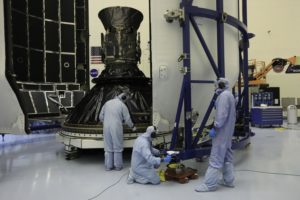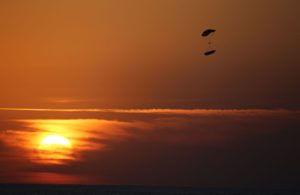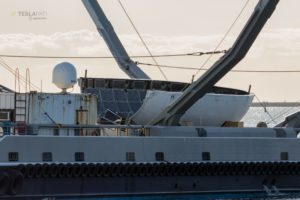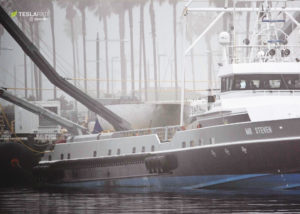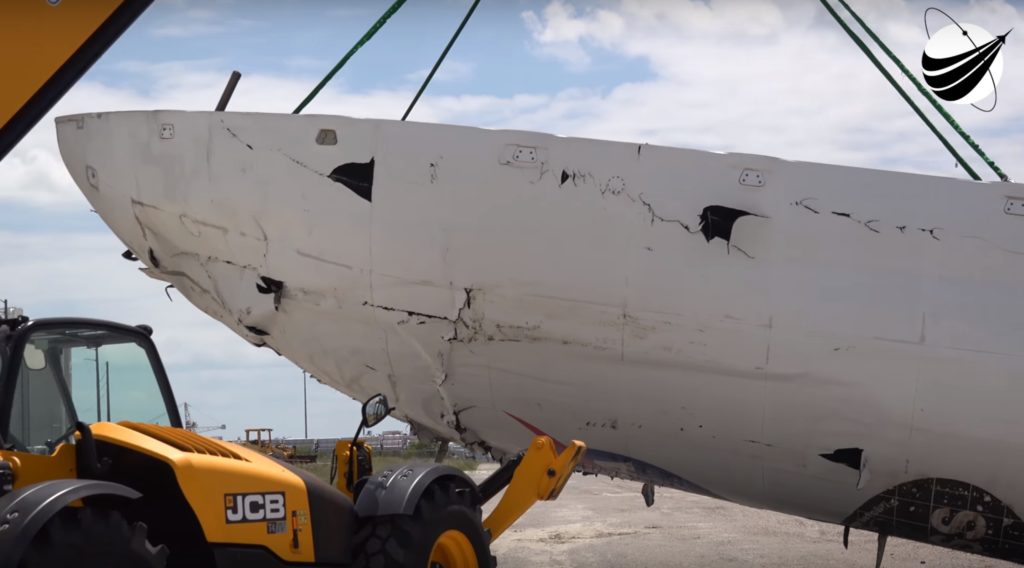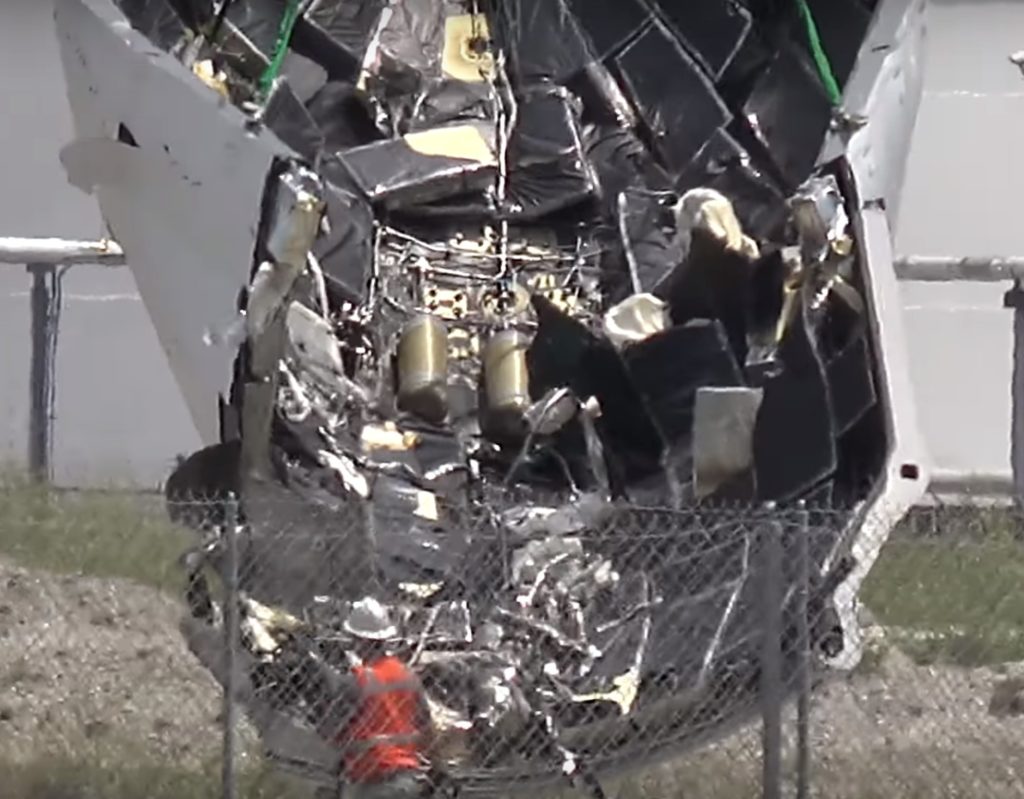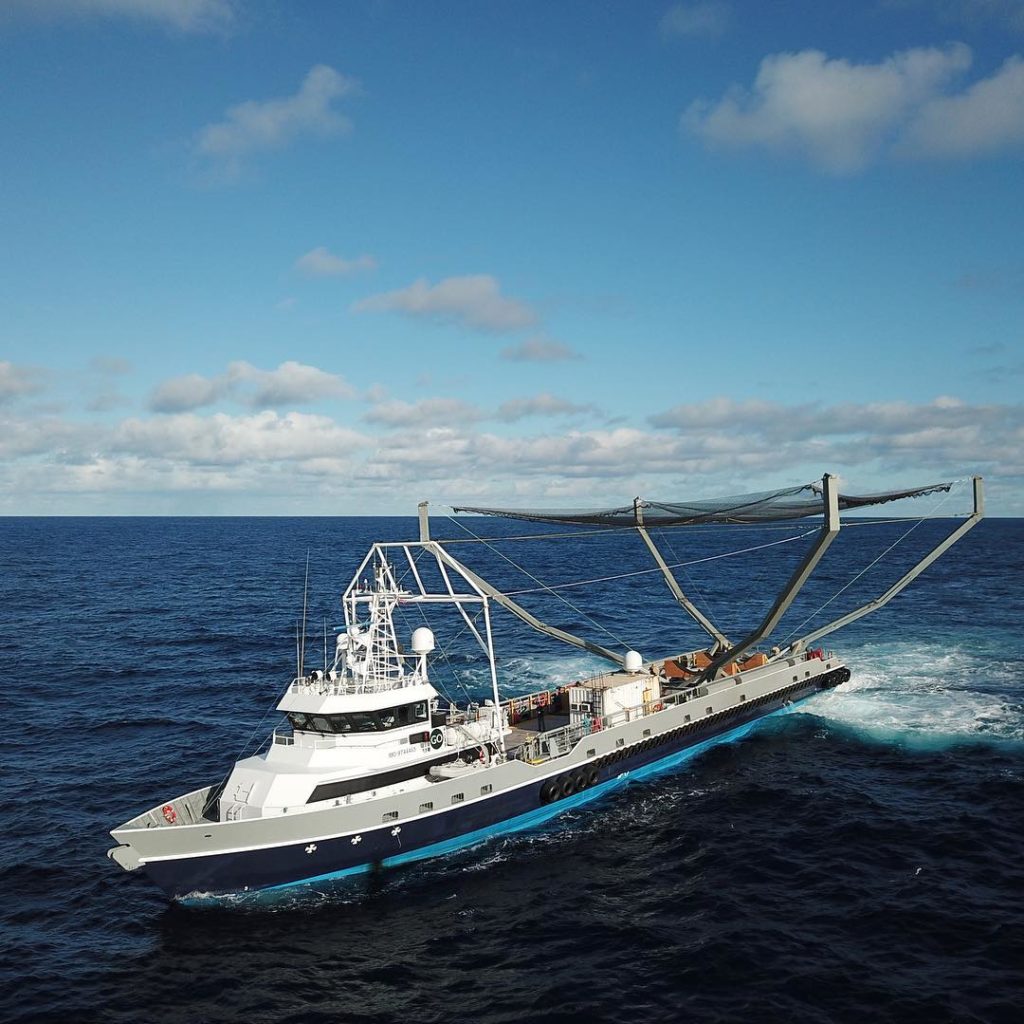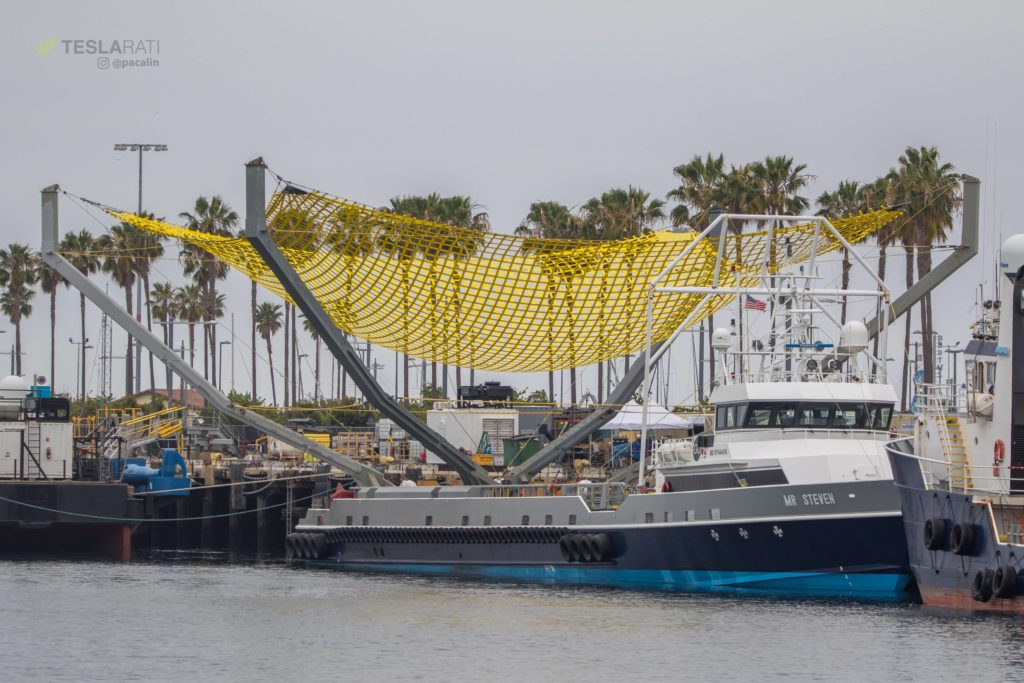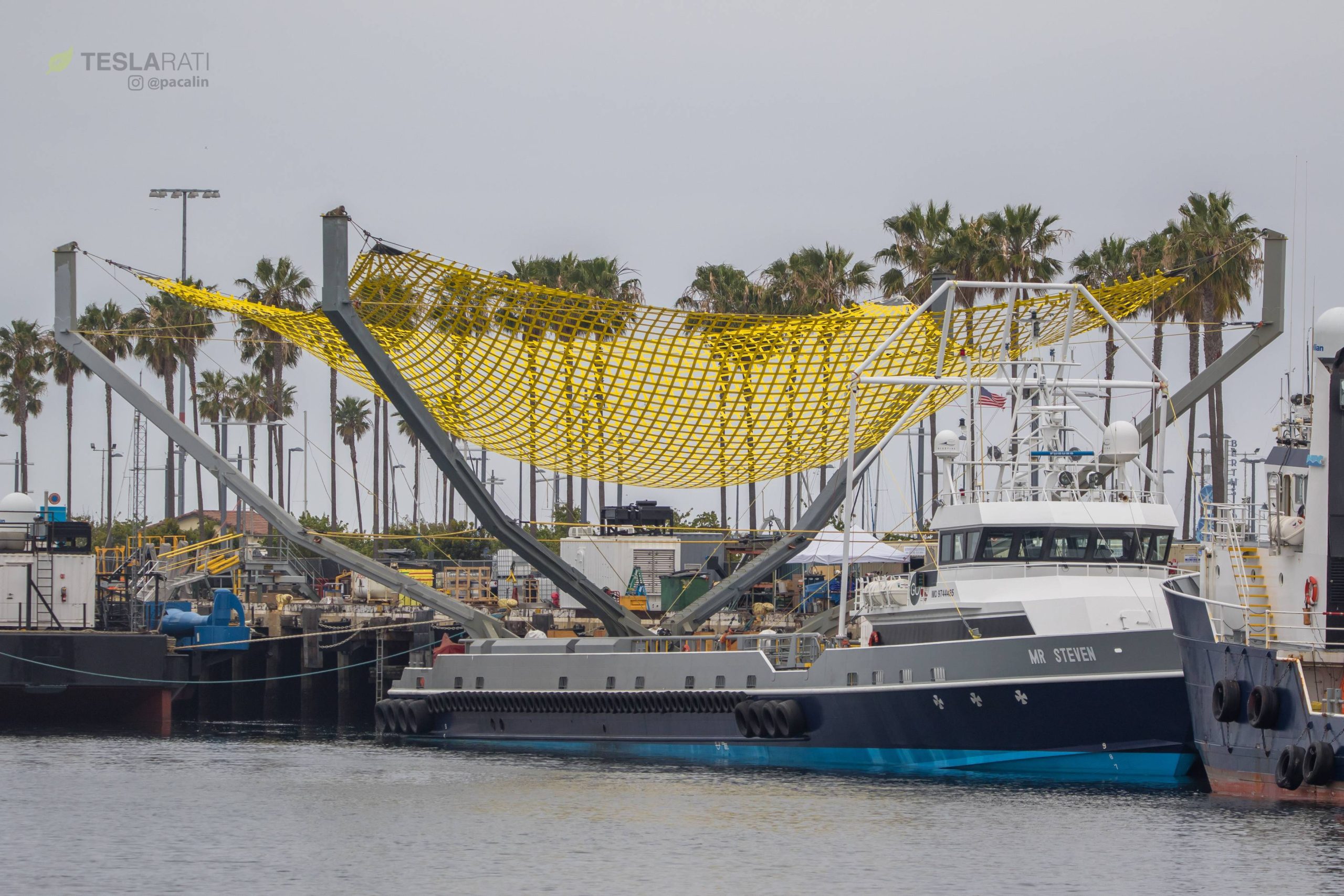
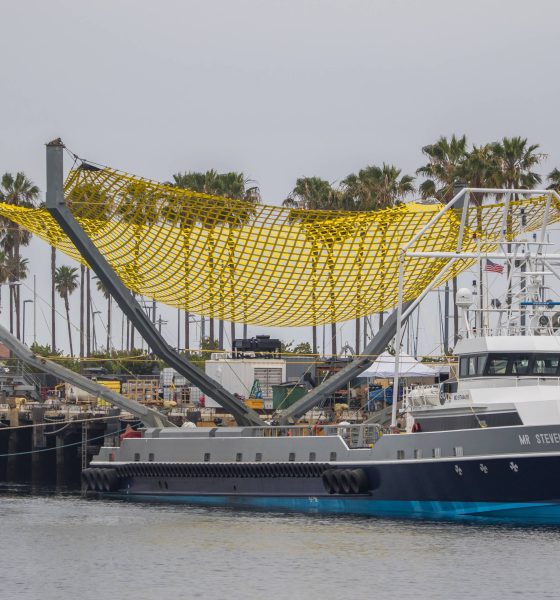
News
SpaceX’s recovery boat Mr Steven has a new net to catch Falcon 9 fairings
While photographer Pauline Acalin just barely missed a toasty Cargo Dragon returning to roost earlier that morning, a routine checkup on SpaceX’s Port of Los Angeles facilities revealed a hefty new net installed on the recovery boat Mr. Steven, as well as noteworthy activity at the huge tent currently harboring the rocket company’s BFR tooling.
After completing a thrillingly routine International Space Station resupply mission (SpaceX’s fourteenth) and spending a month on orbit, the commercial spacecraft reentered Earth’s atmosphere at a respectable 7.5 km/s before splashing down in the Pacific Ocean for the second time. Currently, SpaceX’s Dragon capsule is the only operational spacecraft capable of returning an appreciable amount of cargo from the ISS, and Capsule 110 (1 referring to Dragon 1, 10 referring to the tenth integrated spacecraft) returned even more cargo (nearly 2 mT) than it delivered to the ISS, including the space robot Robonaut 2, various completed experiments, and expired hardware. As of CRS-12, SpaceX has effectively ended production of new Cargo Dragon capsules, and has since flown two additional missions using refurbished capsules, perhaps paving the way for the first-ever triple reuse of an orbital commercial spacecraft. CRS-15, Dragon’s next flight, is currently scheduled for early July.
Here’s the SpaceX Dragon capsule that came back to Earth over the weekend being unloaded in San Pedro’s Outer Harbor this morning. Photo by Chuck Bennett. pic.twitter.com/GBypff51MW
— Megan Barnes (@meg_barnes) May 7, 2018
Although Pauline missed the battle-scarred capsule’s second return to Port of San Pedro, her travels were not for naught. Berthed at SpaceX’s leased dock space, SpaceX recovery technicians appeared to have installed and rigged a brand new net aboard fairing recovery vessel Mr. Steven in the several days between her visits. While he has yet to catch a fairing out of the sky (the ultimate goal of the program), the vessel has returned to land two of three largely intact fairing halves, the only payload fairings to have ever been recovered in one piece after an operational rocket launch. The first successful recovery followed PAZ, and although – per sources familiar with the matter – that particular half experienced catastrophic cracking while being hoisted from the ocean onto Mr. Steven’s deck, it appears that the second intact half (following Iridium-5) did not meet the same fate. It’s probable that – assuming Musk does mean to conduct helicopter drop tests – the structurally-intact Iridium-5 half is thus a prime candidate for air drop tests to perfect the system’s accuracy, as fairings immersed in saltwater are not candidates for operational reuse.
- It’s good to first remember just how huge Falcon payload fairings are. (NASA, 2018)
- Soon after parafoil deployment, a payload fairing is captured gliding gently ahead of a soft ocean landing. (Elon Musk)
- PAZ’s recovered fairing half sadly cracked beyond repair while being hauled aboard Mr Steven. (Pauline Acalin)
- The Iridium-5 half, however, is not believed to have suffered any significant structural damage during recovery ops. (Pauline Acalin)
Meanwhile, several thousand miles to the East, SpaceX nailed their first intact recovery of a fairing half in the Atlantic following the historic and successful launch of NASA’s TESS, an exoplanet observatory that will more than fill the boots soon to be left empty by forlorn Kepler. Likely to discover thousands upon thousands more planets orbiting other stars, it is perhaps fitting that the mission also featured a successful Falcon 9 booster recovery and the first-ever (more or less…) intact recovery of both halves of a payload fairing. One half was absolutely shredded, but USLaunchReport reported that the half not caught on video was in comparatively perfect condition.
Returning to Mr. Steven’s visibly-upgraded catcher’s mitt, the newly-installed net is by all appearances magnitudes larger, heavier, and stronger than the minimal mesh specimen it is clearly replacing. Given the fact that SpaceX thus far has self-admittedly failed to catch a gliding fairing half in the net, it seems unlikely that such a drastic upgrade would be necessitated by any field-testing that occurred since Mr. Steven’s debut late last year. Rather, a significantly more capable net seems to more readily fit alongside CEO Elon Musk’s tweet reveal three weeks prior that SpaceX would attempt to close the final major loop of Falcon reusability by recovering the orbital upper stage (S2). Estimated to weigh approximately 4000 kilograms empty, the upper stage is a minimum of four times heavier than Falcon 9’s payload fairing halves, Mr Steven’s current meal of choice. Judging from the new net’s beefy rigging, broader bars, and general appearance, one could safely argue that it looks at least several times stronger than the mesh net before it. One could also argue that the absolutely massive metal arms installed on Mr. Steven are far larger than what might be required to catch the extremely low mass-to-area ratio payload fairings, with structural heft and bulky netting more reminiscent of safety nets present on naval vessels that are designed to catch aircraft and helicopters weighing five metric tons or more.
- Although both halves clearly attempted soft-landings with parafoils (evidenced by the black metal bars sticking up here), only one of them made it back intact. (USLaunchReport)
- The half not pictured in these photos was reportedly more or less intact, successfully landing in the ocean after launching NASA’s TESS. (USLaunchReport)
- Mr Steven is currently undergoing arm surgery (upgrades) at SpaceX’s future BFR factory lot, known as Berth 240. (Elon Musk)
- Mr Steven and his fancy net 2.0, caught on May 7. Bright yellow…for style. (Pauline Acalin)
Currently scheduled to liftoff around 4:12 p.m. EST May 10 from SpaceX’s LC-39A Florida launch pad, the company’s next mission will send Bangladesh’s first communications satellite – Bangabandhu-1 – to a geostationary transfer orbit. Equally significant, it will hopefully become the successful inaugural flight of Falcon 9 Block 5, a highly reliable and reusable collection of upgrades to the workhorse SpaceX rocket. Soon after, SpaceX will likely aim to complete two additional launches in late May, one from California’s Vandenberg Air Force Base (Iridium-6/GRACE-FO) and the other from LC-40 in Cape Canaveral (SES-12). While the latter two launches – per their flight-proven boosters – will be expended, the first Block 5 booster (B1046) will attempt to land aboard drone ship Of Course I Still Love You, already on station in the Atlantic.
Follow us for live updates, behind-the-scenes sneak peeks, and a sea of beautiful photos from our East and West coast photographers.
Teslarati – Instagram – Twitter
Tom Cross – Twitter
Pauline Acalin – Twitter
Eric Ralph – Twitter

News
Tesla hints at Starlink integration with recent patent
“By employing polymer blends, some examples enable RF transmission from all the modules to satellites and other communication devices both inside and outside the vehicle.”

Tesla hinted at a potential Starlink internet terminal integration within its vehicles in a recent patent, which describes a vehicle roof assembly with integrated radio frequency (RF) transparency.
The patent, which is Pub. No U.S. 2025/0368267 describes a new vehicle roof that is made of RF-transparent polymer materials, allowing and “facilitating clear communication with external devices and satellites.”
Tesla believes that a new vehicle roof design, comprised of different materials than the standard metallic or glass elements used in cars today, would allow the company to integrate modern vehicular technologies, “particularly those requiring radio frequency transmission and reception.
Tesla has recently filed a US patent application on integrating RF transparent materials into the roof structure.
“facilitating clear communication with external devices and satellites”
Tesla fleet is getting @Starlink connectivity integration soon. LFG @Tesla @elonmusk… pic.twitter.com/bLa8YtPLd1
— Chansoo Byeon (@Chansoo) December 9, 2025
Instead of glass or metallic materials, Tesla says vehicles may benefit from high-strength polymer blends, such as Polycarbonate, Acrylonitrile Butadiene Styrene, or Acrylonitrile Styrene Acrylate.
These materials still provide ideal strength metrics for crashworthiness, stiffness for noise, vibration, and harshness control, and are compliant with head impact regulations.
They would also enable better performance with modern technologies, like internet terminals, which need an uninterrupted signal to satellites for maximum reception. Tesla writes in the patent:
“By employing polymer blends, some examples enable RF transmission from all the modules to satellites and other communication devices both inside and outside the vehicle.”

One of the challenges Tesla seems to be aware of with this type of roof design is the fact that it will still have to enable safety and keep that at the forefront of the design. As you can see in the illustration above, Tesla plans to use four layers to increase safety and rigidity, while also combating noise and vibration.
It notes in the patent that disclosed examples still meet the safety requirements outlined in the Federal Motor Vehicle Safety Standards (FMVSS).
Starlink integrated directly into Tesla vehicles would be a considerable advantage for owners. It would come with a handful of distinct advantages.
Initially, the inclusion of Starlink would completely eliminate cellular dead zones, something that is an issue, especially in rural areas. Starlink would provide connectivity in these remote regions and would ensure uninterrupted service during road trips and off-grid adventures.
It could also be a critical addition for Robotaxi, as it is crucial to have solid and reliable connectivity for remote monitoring and fleet management.
Starlink’s growing constellation, thanks to SpaceX’s routine and frequent launch schedule, will provide secure, stable, and reliable internet connectivity for Tesla vehicles.
Although many owners have already mounted Starlink Mini dishes under their glass roofs for a similar experience, it may be integrated directly into Teslas in the coming years, either as an upgrade or a standard feature.
News
Tesla supplements Holiday Update by sneaking in new Full Self-Driving version
It seems Tesla was waiting for the Hardware 4 rollout, as it wanted to also deploy a new Full Self-Driving version to those owners, as it appeared in the release notes for the Holiday Update last night.

Tesla has surprised some owners by sneaking in a new Full Self-Driving version with the wide release of the Holiday Update, which started rolling out to Hardware 4 owners on Friday night.
Tesla has issued a controlled and very slow release pattern with the Holiday Update, which rolls out with Software Version 2025.44.25.5.
For the past two weeks, as it has rolled out to Hardware 3 and older Tesla owners, the company has kept its deployment of the new Software Version relatively controlled.
It seems Tesla was waiting for the Hardware 4 rollout, as it wanted to also deploy a new Full Self-Driving version to those owners, as it appeared in the release notes for the Holiday Update last night.
Tesla Full Self-Driving v14.2.1.25 made its first appearance last night to Hardware 4 owners who are members of the Early Access Program (EAP). It appears to be a slight refinement from FSD v14.2.1, which has been out for a couple of weeks.
Tesla v2025.44.25.5 Holiday update incoming
Also Full Self-Driving v14.2.1.25!!! pic.twitter.com/74D7S0UGXz
— TESLARATI (@Teslarati) December 13, 2025
Many owners welcome the new FSD version, us included, because we’ve been less than impressed with v14.2.1. We have experienced some minor regressions with v14.2.1, especially with Speed Limit recognition, Speed Profile tinkering, and parking performance.
As it stands, Full Self-Driving is still particularly impressive, but Tesla is evidently having an issue with some of the adjustments, as it is still refining some of the performance aspects of the suite. This is expected and normal with some updates, as not all of them are an improvement in all areas; we routinely see some things backtrack every once in a while.
This new FSD version is likely to take care of those things, but it also includes all of the awesome Holiday Update features, which include:
- Grok with Navigation Commands (Beta) – Grok will now add and edit destinations.
- Tesla Photobooth – Take pictures inside your car using the cabin-facing camera
- Dog Mode Live Activity – Check on your four-legged friend on your phone through periodic snapshots taken of the cabin
- Dashcam Viewer Update – Includes new metrics, like steering wheel angle, speed, and more
- Santa Mode – New graphics, trees, and a lock chime
- Light Show Update – Addition of Jingle Rush light show
- Custom Wraps and License Plates – Colorizer now allows you to customize your vehicle even further, with custom patterns, license plates, and tint
- Navigation Improvements – Easier layout and setup
- Supercharger Site Map – Starting at 18 pilot locations, a 3D view of the Supercharger you’re visiting will be available
- Automatic Carpool Lane Routing – Navigation will utilize carpool lanes if enabled
- Phone Left Behind Chime – Your car will now tell you if you left a phone inside
- Charge Limit Per Location – Set a charge limit for each location
- ISS Docking Simulator – New game
- Additional Improvements – Turn off wireless charging pad, Spotify improvements, Rainbow Rave Cave, Lock Sound TRON addition
Tesla also added two other things that were undocumented, like Charging Passport and information on USB drive storage to help with Dashcam.
Cybertruck
Tesla updates Cybertruck owners about key Powershare feature

Tesla is updating Cybertruck owners on its timeline of a massive feature that has yet to ship: Powershare with Powerwall.
Powershare is a bidirectional charging feature exclusive to Cybertruck, which allows the vehicle’s battery to act as a portable power source for homes, appliances, tools, other EVs, and more. It was announced in late 2023 as part of Tesla’s push into vehicle-to-everything energy sharing, and acting as a giant portable charger is the main advantage, as it can provide backup power during outages.
Cybertruck’s Powershare system supports both vehicle-to-load (V2L) and vehicle-to-home (V2H), making it flexible and well-rounded for a variety of applications.
However, even though the feature was promised with Cybertruck, it has yet to be shipped to vehicles. Tesla communicated with owners through email recently regarding Powershare with Powerwall, which essentially has the pickup act as an extended battery.
Powerwall discharge would be prioritized before tapping into the truck’s larger pack.
However, Tesla is still working on getting the feature out to owners, an email said:
“We’re writing to let you know that the Powershare with Powerwall feature is still in development and is now scheduled for release in mid-2026.
This new release date gives us additional time to design and test this feature, ensuring its ability to communicate and optimize energy sharing between your vehicle and many configurations and generations of Powerwall. We are also using this time to develop additional Powershare features that will help us continue to accelerate the world’s transition to sustainable energy.”
Owners have expressed some real disappointment in Tesla’s continuous delays in releasing the feature, as it was expected to be released by late 2024, but now has been pushed back several times to mid-2026, according to the email.
Foundation Series Cybertruck buyers paid extra, expecting the feature to be rolled out with their vehicle upon pickup.
Cybertruck’s Lead Engineer, Wes Morrill, even commented on the holdup:
As a Cybertruck owner who also has Powerwall, I empathize with the disappointed comments.
To their credit, the team has delivered powershare functionality to Cybertruck customers who otherwise have no backup with development of the powershare gateway. As well as those with solar…
— Wes (@wmorrill3) December 12, 2025
He said that “it turned out to be much harder than anticipated to make powershare work seamlessly with existing Powerwalls through existing wall connectors. Two grid-forming devices need to negotiate who will form and who will follow, depending on the state of charge of each, and they need to do this without a network and through multiple generations of hardware, and test and validate this process through rigorous certifications to ensure grid safety.”
It’s nice to see the transparency, but it is justified for some Cybertruck owners to feel like they’ve been bait-and-switched.
